Paper Menu >>
Journal Menu >>
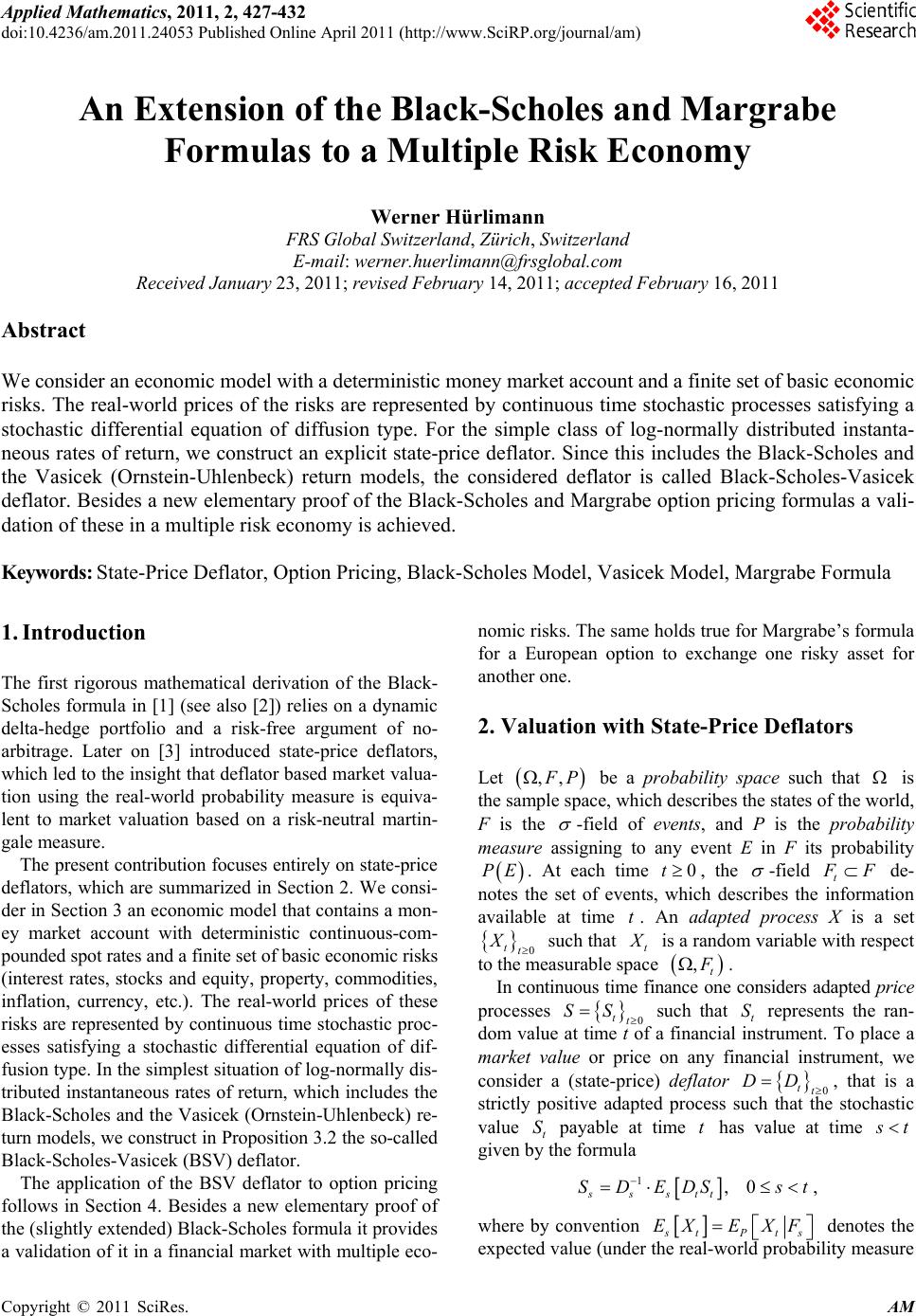 Applied Mathematics, 2011, 2, 427-432 doi:10.4236/am.2011.24053 Published Online April 2011 (http://www.SciRP.org/journal/am) Copyright © 2011 SciRes. AM An Extension of the Black-Scholes and Margrabe Formulas to a Multiple Risk Economy Werner Hürlimann FRS Global Switzerland, Zürich, Switzerland E-mail: werner.huerlimann@frsglobal.com Received January 23, 2011; revised February 14, 2011; accepted Februar y 16, 2011 Abstract We consider an economic model with a deterministic money market account and a finite set of basic economic risks. The real-world prices of the risks are represented by continuous time stochastic processes satisfying a stochastic differential equation of diffusion type. For the simple class of log-normally distributed instanta- neous rates of return, we construct an explicit state-price deflator. Since this includes the Black-Scholes and the Vasicek (Ornstein-Uhlenbeck) return models, the considered deflator is called Black-Scholes-Vasicek deflator. Besides a new elementary proof of the Black-Scholes and Margrabe option pricing formulas a vali- dation of these in a multiple risk economy is achieved. Keywords: State-Price Deflator, Option Pricing, Black-Scholes Model, Vasicek Model, Margrabe Formula 1. Introduction The first rigorous mathematical derivation of the Black- Scholes formula in [1] (see also [2]) relies on a dynamic delta-hedge portfolio and a risk-free argument of no- arbitrage. Later on [3] introduced state-price deflators, which led to the insight th at deflator based market valu a- tion using the real-world probability measure is equiva- lent to market valuation based on a risk-neutral martin- gale measure. The present contribution focuses entirely on state-price deflators, which are summarized in Section 2. We consi- der in Section 3 an economic model that contains a mon- ey market account with deterministic continuous-com- pounded spot rates and a finite set of basic economic risks (interest rates, stocks and equity, property, commodities, inflation, currency, etc.). The real-world prices of these risks are represented by continuous time stochastic proc- esses satisfying a stochastic differential equation of dif- fusion type. In the simplest situation of log-normally dis- tributed instantaneous rates of return, which includes the Black-Scholes and the Vasicek (Ornstein-Uhlenbeck) re- turn models, we construct in Proposition 3.2 the so-called Black-Scholes-Vasicek (BSV) deflator. The application of the BSV deflator to option pricing follows in Section 4. Besides a new elementary proof of the (slightly extended) Black-Scholes formula it provides a validation of it in a financial market with multiple eco - nomic risks. The same holds true for Margrabe’s formula for a European option to exchange one risky asset for another one. 2. Valuation with State-Price Deflators Let ,, F P be a probability space such that is the sample space, which describes the states of the world, F is the -field of events, and P is the probability measure assigning to any event E in F its probability PE. At each time 0t, the -field t F F de- notes the set of events, which describes the information available at time t. An adapted process X is a set 0 tt X such that t X is a random variable with respect to the measurable space ,t F . In continuous time finance one considers adapted price processes 0 tt SS such that t S represents the ran- dom value at time t of a financial instrument. To place a market value or price on any financial instrument, we consider a (state-price) deflator 0 tt DD , that is a strictly positive adapted process such that the stochastic value t S payable at time t has value at time t s given by the f o rmula 1,0 ssstt SDEDS st , where by convention s tPts EXE XF denotes the expected valu e (u nder the real-world p robability measure 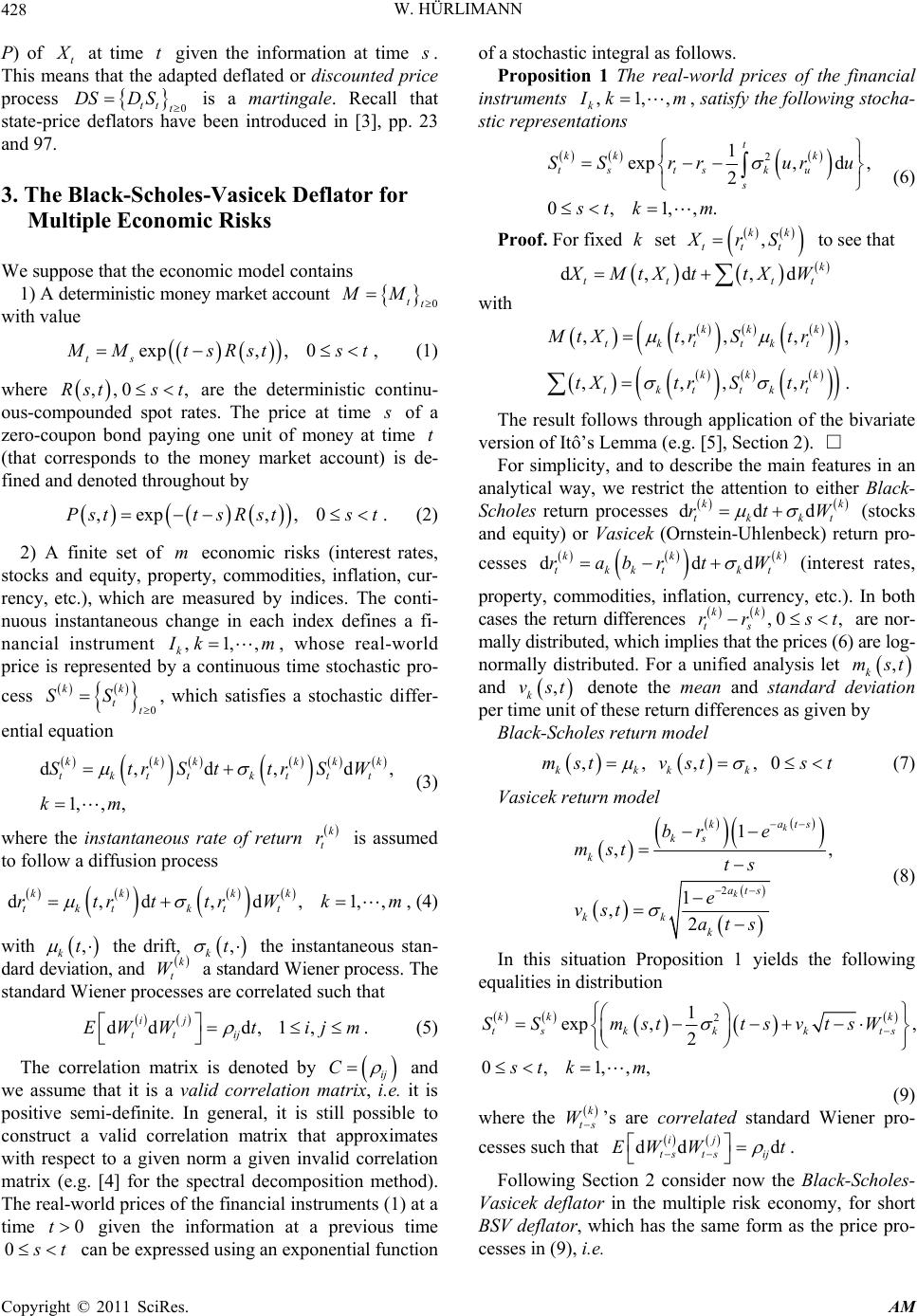 W. HÜRLIMANN Copyright © 2011 SciRes. AM 428 P) of t X at time t given the information at time s . This means that the adapted deflated or discounted price process 0 ttt DSD S is a martingale. Recall that state-price deflators have been introduced in [3], pp. 23 and 97. 3. The Black-Scholes-Vasicek Deflator for Multiple Economic Risks We suppose that the economic model contains 1) A deterministic money market account 0 tt MM with value exp,, 0 ts M MtsRst st , (1) where ,,0 ,Rsts t are the deterministic continu- ous-compounded spot rates. The price at time s of a zero-coupon bond paying one unit of money at time t (that corresponds to the money market account) is de- fined and denoted throughout by ,exp ,,0Pstt sRstst . (2) 2) A finite set of m economic risks (interest rates, stocks and equity, property, commodities, inflation, cur- rency, etc.), which are measured by indices. The conti- nuous instantaneous change in each index defines a fi- nancial instrument ,1,, k I km, whose real-world price is represented by a continuous time stochastic pro- cess 0 kk tt SS , which satisfies a stochastic differ- ential equation d,d,d, 1,, , kkkkkk tktt kttt StrSttrSW km (3) where the instantaneous rate of return k t r is assumed to follow a diffusion process d,d,d,1,, kk kk tktkt t rtrttrWkm , (4) with , kt the drift, , kt the instantaneous stan- dard deviation, and k t W a standard Wiener process. The standard Wiener processes are correlated such that dd d,1, ij tt ij EW Wtijm . (5) The correlation matrix is denoted by ij C and we assume that it is a valid correlation matrix, i.e. it is positive semi-definite. In general, it is still possible to construct a valid correlation matrix that approximates with respect to a given norm a given invalid correlation matrix (e.g. [4] for the spectral decomposition method). The real-world prices of the financial instruments (1) at a time 0t given the information at a previous time 0 s t can be expressed using an exponentia l function of a stochastic integral as follows. Proposition 1 The real-world prices of the financial instruments ,1,, k I km , satisfy the following stocha- stic representations 2 1 exp,d , 2 0,1,,. t kk k tsts ku s SS rruru st km (6) Proof. For fixed k set , kk ttt XrS to see that d,d,d k tt tt XMtXttXW with ,,,, kk k tkttkt MtXtr Str , ,,,, kk k tkttkt tXtr Str . The result follows through application of the bivariate version of Itô’s Lemma (e.g. [5], Section 2). □ For simplicity, and to describe the main features in an analytical way, we restrict the attention to either Black- Scholes return processes ddd kk tkkt rtW (stocks and equity) or Vasicek (Ornstein-Uhlenbeck) return pro- cesses ddd kkk tkktkt rabrt W (interest rates, property, commodities, inflation, currency, etc.). In both cases the return differences ,0 , kk ts rr st are nor- mally distributed, which implies that the prices (6) are log- normally distributed. For a unified analysis let , k mst and , k vst denote the mean and standard deviation per time unit of these return differences as given by Black-Scholes return model ,, ,, 0 kkkk mst vstst (7) Vasicek return model 2 1 ,, 1 ,2 k k kats ks k ats kk k br e mst ts e vst ats (8) In this situation Proposition 1 yields the following equalities in distribution 2 1 exp ,, 2 0,1,,, kk k tskkk ts SS msttsvtsW st km (9) where the k ts W ’s are correlated standard Wiener pro- cesses such that dd d ij ts tsij EW Wt . Following Section 2 consider now the Black-Scholes- Vasicek deflator in the multiple risk economy, for short BSV deflator, which has the same form as the price pro- cesses in (9), i.e. 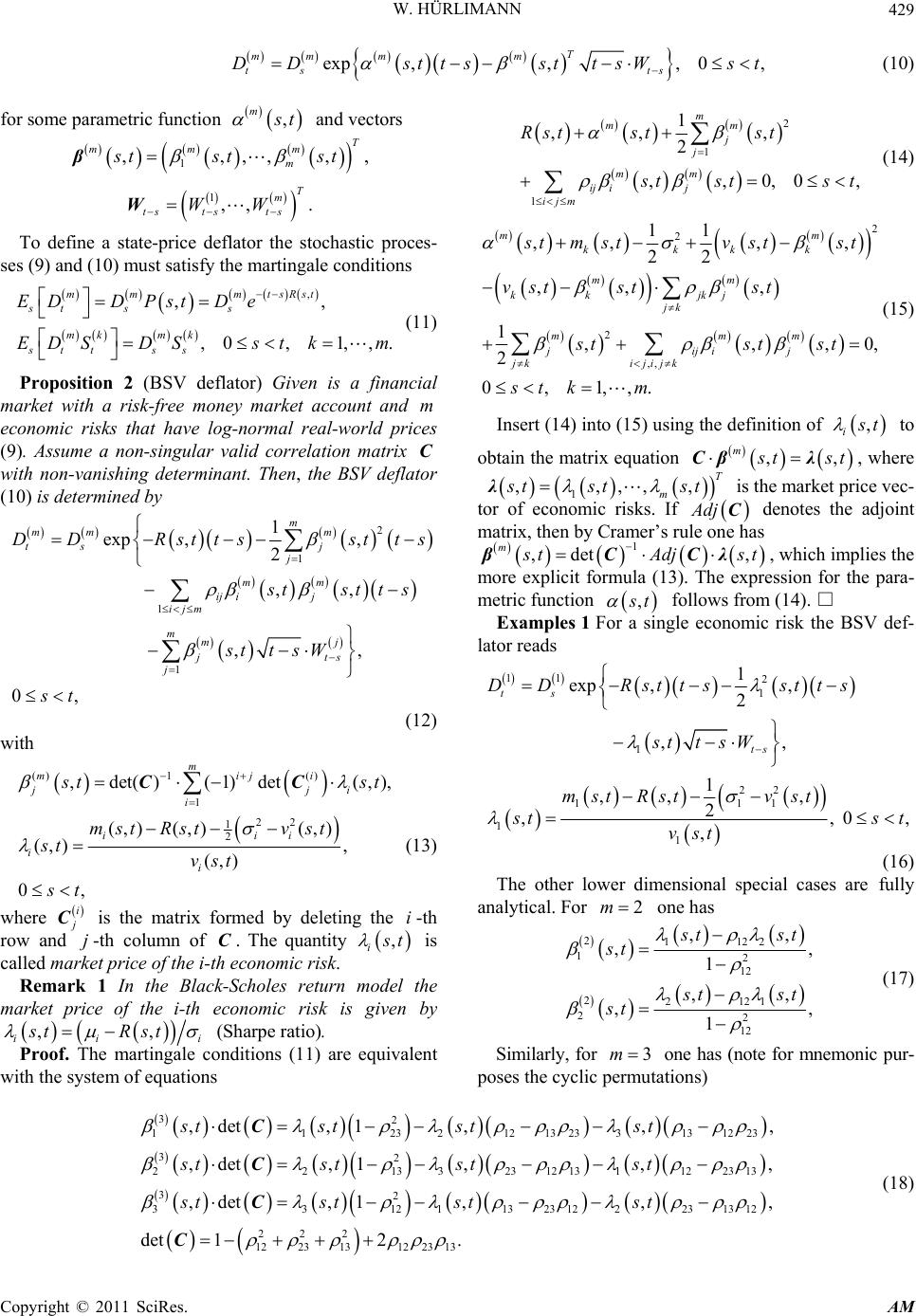 W. HÜRLIMANN Copyright © 2011 SciRes. AM 429 exp,,, 0, T mm mm ts ts DDsttssttsWst (10) for some parametric function , m s t and vectors 1 ,,,,, T mm m m s tst st β, 1,, T m ts tsts WW W. To define a state-price deflator the stochastic proces- ses (9) and (10) must satisfy the martingale conditions , ,, ,0, 1,,. mm mtsRst st ss mk mk stt ss EDDPst De EDSDSst km (11) Proposition 2 (BSV deflator) Given is a financial market with a risk-free money market account and m economic risks that have log-normal real-world prices (9). Assume a non-singular valid correlation matrix C with non-vanishing determinant. Then, the BSV deflator (10) is determined by 2 1 1 1 1 exp ,, 2 ,, ,, 0, m mm m ts j j mm ij ij ijm mmj jts j DD Rsttsstts s tstts sttsW st (12) with () 1() 1 22 1 2 ,det()(1)det(,), (,)(,)(,) (,) , (,) 0, m miji jji i iii ii s tst mstRstv st st vst st CC (13) where i j C is the matrix formed by deleting the i-th row and j-th column of C. The quantity , i s t is called market price of the i-th economic risk. Remark 1 In the Black-Scholes return model the market price of the i-th economic risk is given by ,, ii i stR st (Sharpe ratio). Proof. The martingale conditions (11) are equivalent with the system of equations 2 1 1 1 ,, , 2 ,,0,0, m mm j j mm ij ij ijm Rst stst s tst st (14) 2 2 2 ,, 11 ,,, , 22 ,,, 1,,,0, 2 0,1,,. mm kkkk mm kk jkj jk mmm jijij jk ijijk s tmstvstst vst stst stst st st km (15) Insert (14) into (15) using the definition of , i s t to obtain the matrix equation ,, m s tstCβλ, where 1 ,,,,, T m s tst st λ is the market price vec- tor of economic risks. If Adj C denotes the adjoint matrix, then by Cramer’s rule one has 1 ,det , m s tAdjst βCCλ, which implies the more explicit formula (13). The expression for the para- metric function , s t follows from (14). □ Examples 1 For a single economic risk the BSV def- lator reads 11 2 1 1 22 111 11 1 exp ,, 2 ,, 1 ,, , 2 ,, 0, , ts ts D DRsttsstts stt sW mstRstv st s tst vst (16) The other lower dimensional special cases are fully analytical. For 2m one has 21122 12 12 22121 22 12 ,, ,, 1 ,, ,, 1 s tst st s tst st (17) Similarly, for 3m one has (note for mnemonic pur- poses the cyclic permutations) 32 112321213 2331312 23 32 221332312 1311223 13 32 331211323 1222313 12 222 1223131223 13 ,det ,1,,, ,det ,1,,, ,det ,1,,, det 12 st st stst stst stst stst stst C C C C. (18) 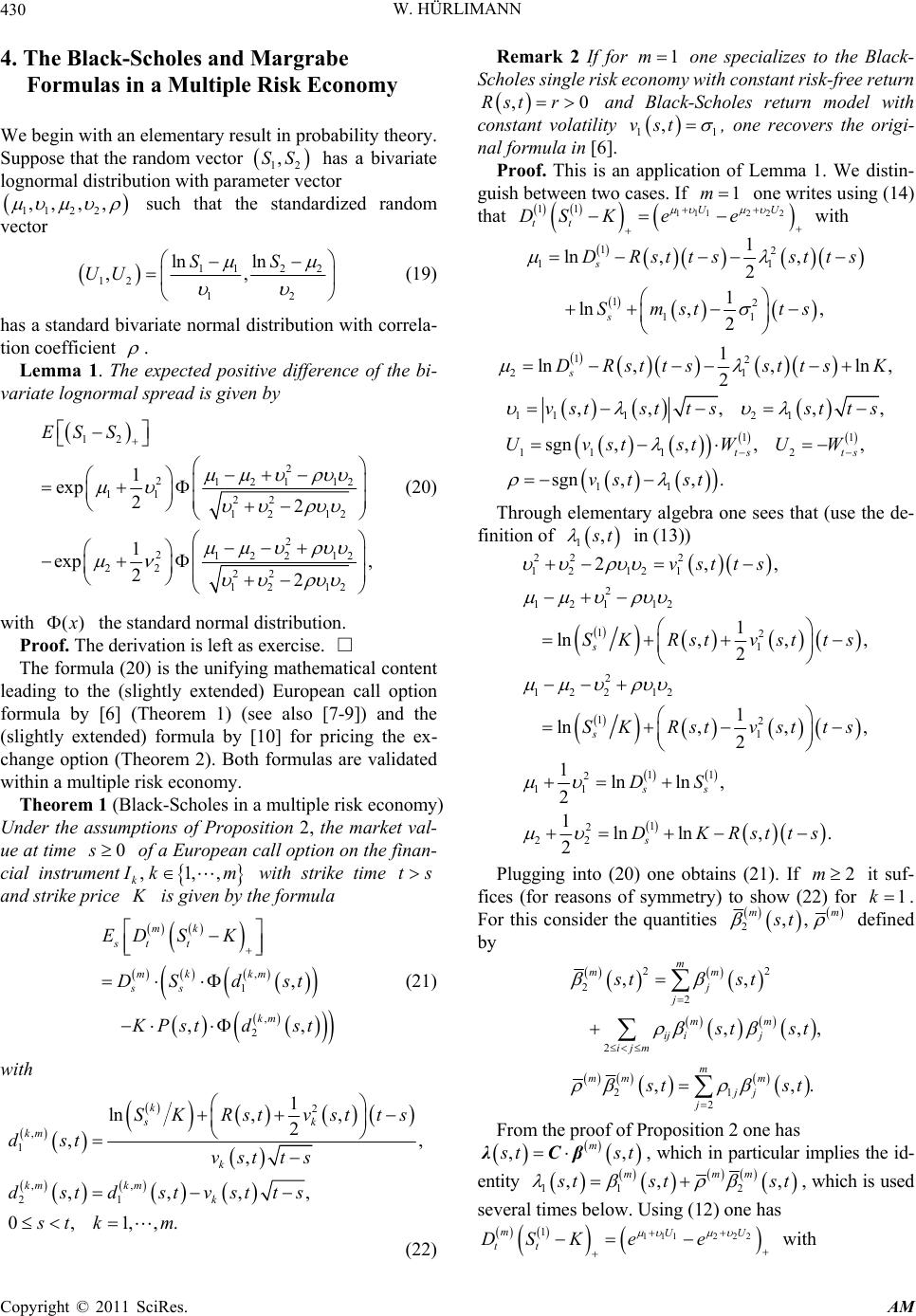 W. HÜRLIMANN Copyright © 2011 SciRes. AM 430 4. The Black-Scholes and Margrabe Formulas in a Multiple Risk Economy We begin with an elementary result in probability theory. Suppose that the random vector 12 ,SS has a bivariate lognormal distribution with parameter vector 112 2 ,, ,, such that the standardized random vector 112 2 12 12 ln ln ,, SS UU (19) has a standard bivariate normal distribution with correla- tion coefficient . Lemma 1. The expected positive difference of the bi- variate lognorma l spread is given by 12 2 2121 12 11 22 12 12 2 2122 12 22 22 12 12 1 exp 22 1 exp , 22 ES S (20) with )(x the standard normal distribution. Proof. The derivation is left as exercise. □ The formula (20) is the unifying mathematical content leading to the (slightly extended) European call option formula by [6] (Theorem 1) (see also [7-9]) and the (slightly extended) formula by [10] for pricing the ex- change option (Theorem 2). Both formulas are validated within a multiple risk economy. Theorem 1 (Black-Scholes in a multiple risk economy) Under the assumptions of Proposition 2, the market val- ue at time 0s of a European call option on the finan- cial instrument ,1,, k I km with strike time ts and strike price K is give n by the for m ula , 1 , 2 , ,, mk st t mk km ss km ED SK DSdst K Pst d st (21) with 2 , 1 ,, 21 1 ln, , 2 ,, , ,,,, 0,1,,. k sk km k kmkm k SK Rstvstts dst vst ts dstdstvstts st km (22) Remark 2 If for 1m one specializes to the Black- Scholes single risk economy with constant risk-free return ,0Rst r and Black-Scholes return model with constant volatility 11 ,vst , one recovers the origi- nal formula in [6]. Proof. This is an application of Lemma 1. We distin- guish between two cases. If 1m one writes using (14) that 1112 22 11 UU tt DS Kee with 12 11 12 11 1 ln ,, 2 1 ln ,, 2 s s DRst tsstt s Smst ts 12 21 1 ln,,ln , 2 s DRst tssttsK 11 121 11 111 2 11 ,,, ,, sgn ,,,, sgn,,. ts ts vststtsst ts Uv ststWUW vst st Through elementary algebra one sees that (use the de- finition of 1, s t in (13)) 22 2 12 121 2 121 12 12 1 2 122 12 12 1 11 2 11 1 2 22 2,, 1 ln,, , 2 1 ln,, , 2 1lnln , 2 1ln ln,. 2 s s ss s vstts SK Rstvstts SK Rstvstts DS DKRstts Plugging into (20) one obtains (21). If 2m it suf- fices (for reasons of symmetry) to show (22) for 1k . For this consider the quantities 2,, mm st defined by 22 22 2 21 2 ,, ,,, ,,. m mm j j mm ij ij ijm m mm m jj j st st s tst s tst From the proof of Proposition 2 one has ,, m s tstλCβ, which in particular implies the id- entity 11 2 ,, , mmm s tst st , which is used several times below. Using (12) one has 1112 22 1mUU tt DS Kee with 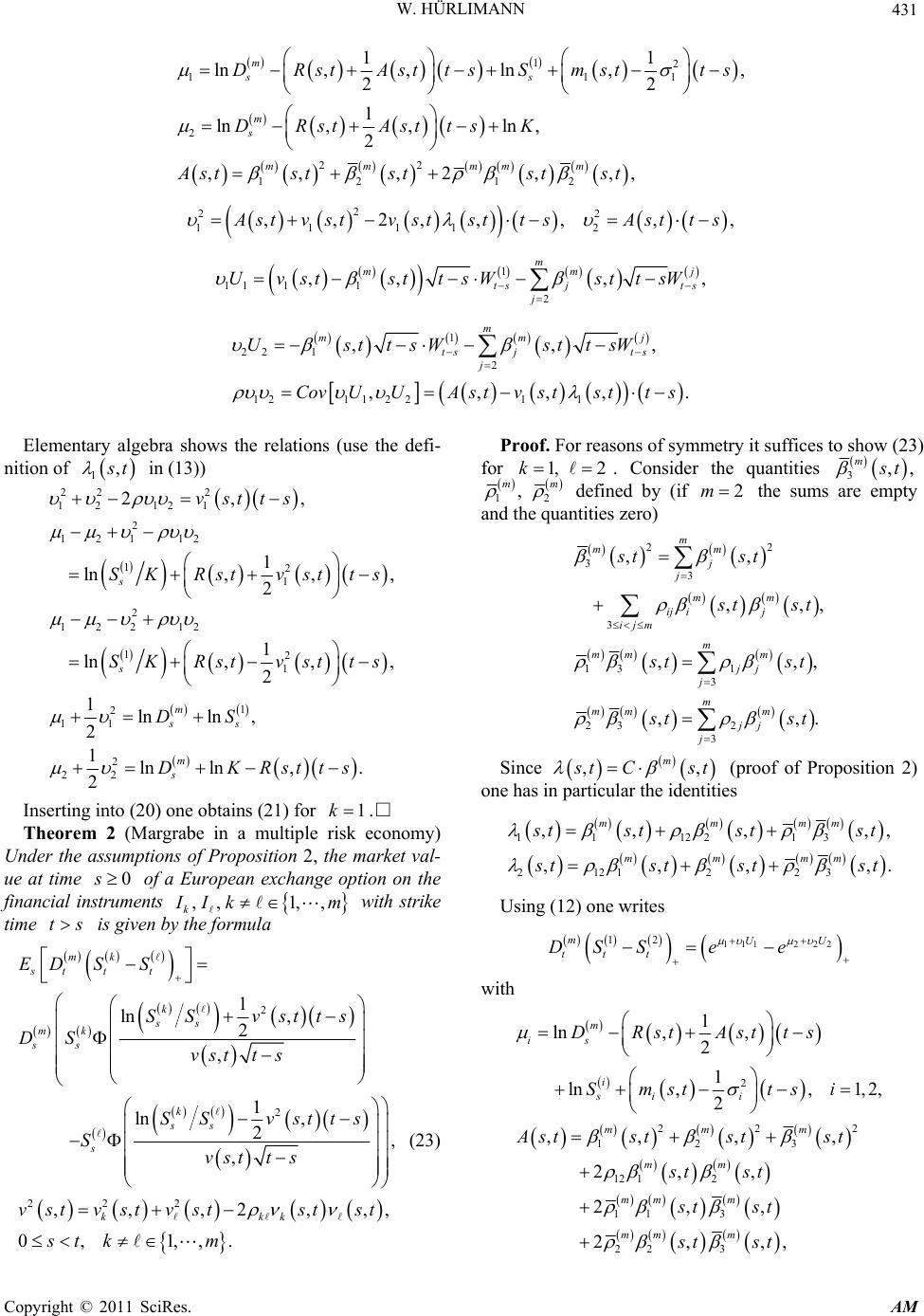 W. HÜRLIMANN Copyright © 2011 SciRes. AM 431 12 111 2 22 12 12 11 ln, ,ln,, 22 1 ln,,ln , 2 ,, ,2,,, m ss m s mm mmm DRstAsttsSmst ts DRstAsttsK Astststst st 2 2 2 1111 2 ,,2,,, ,, A stvstvststt sAstt s 1 11 112 ,,, , m mmj ts jts j Uvststt sWsttsW 1 22 12 121 12211 ,,, ,,,,. m mmj ts jts j UsttsWsttsW CovUUAstvs ts tts Elementary algebra shows the relations (use the defi- nition of 1, s t in (13)) 22 2 12 121 2 121 12 12 1 2 122 12 12 1 1 2 11 2 22 2,, 1 ln,, , 2 1 ln,, , 2 1lnln , 2 1ln ln,. 2 s s m ss m s vstts SK Rstvstts SK Rstvstts DS DKRstts Inserting into (20) one obtains (21) for 1k.□ Theorem 2 (Margrabe in a multiple risk economy) Under the assumptions of Proposition 2, the market val- ue at time 0s of a European exchange option on the financial instruments ,, 1,, k I Ik m with strike time ts is given by the formula 2 2 222 1 ln , 2 , 1 ln , 2 , , ,,,2,,, 0, 1,,. mk st tt k ss mk ss k ss s kkk ED SS SS vstts DS vstt s SS vstts Svstt s vstvst vststst st km (23) Proof. For reasons of symmetry it suffices to show (23) for 1, 2k . Consider the quantities 3,, m s t 12 , mm defined by (if 2m the sums are empty and the quantities zero) 22 33 3 13 1 3 23 2 3 ,, ,,, ,,, ,,. m mm j j mm ij ij ijm m mm m jj j m mm m jj j st st s tst s tst s tst Since ,, m s tC st (proof of Proposition 2) one has in particular the identities 1112213 2121 2 23 ,, ,,, ,,,,. mmmm mmmm s tst stst s tstst st Using (12) one writes 1112 22 12mUU tt t DS See with 2 222 123 12 12 11 3 22 3 1 ln, , 2 1 ln,, 1,2, 2 ,, , , 2,, 2,, 2,,, m is i si i mmm mm mm m mm m DRstAstts Smst tsi Ast ststst st st st st st st  W. HÜRLIMANN Copyright © 2011 SciRes. AM 432 2 2 1111 2 2 2222 1 11 11 2 23 1 22 1 2 22 3 12 ,,2,, , ,,2,, , ,, ,,, , ,, ,, mts m mmj ts jts j mts mts mmj jts j A stv stv ststts A stvstv ststt s Uv ststtsW stt sWsttsW UsttsW vstst tsW stt sW Cov 112 2 112 2 12 12 , ,,,,, ,,. UU Ast vstst vstst vstvst ts One obtains the relations (use again the definition of ,, 1,2 ist i in (13)) 22 12 12 22 12 1212 2 2 121 12 12 2 2 122 12 12 2 2 2 ,,2,, ,, 1 ln, , 2 1 ln, , 2 1lnln ,1,2. 2 ss ss mi ii ss v stv stststt s vst ts SS vstts SS vstts DSi Inserting into (20) one obtains the Formula (23) for 1, 2k.□ It might be useful to conclude with a short summary. If one starts with the stochastic representation (9) of the real-world prices for the risks in the economy, the deri- vation of the formulas is rather elementary. It only uses introductory Probability Theory (including the notion of Martingale) and Linear Algebra. Therefore, the proof is accessible to any knowledgeable person in these mathe- matical areas. Moreover, the approach is different from the original one (hedging argument, use of Itô’s Lemma and solution of a partial differential equ ation). It leads to new insight in Option Pricing Theory. Besides a general validation in a multiple risk economy, the proposed de- rivation implies a risk-neutral property of independent interest, i.e. the formulas are invariant with respect to the market prices of the risk factors. 5. References [1] R. C. Merton, “Theory of Rational Option Pricing,” Bell Journal of Economics and Management Science, Vol. 4, No. 8, 1973, pp. 141-183. Reprinted in [2]. doi:10.2307/3003143 [2] R. C. Merton, “Continuous-Time Finance,” Basil Black- well, 1990. [3] D. Duffie, “Dynamic Asset Pricing Theory,” Princeton University Press, New Jersey, 1992. [4] R. Rebonato and P. Jäckel, “The Most General Metho- dology to Create a Valid Correlation Matrix for Risk Management and Option Pricing Purposes,” Journal of Risk, Vol. 2, No. 2, 2000, pp. 17-27. [5] W. Hürlimann, “Méthodes Stochastiques D'évaluation du Rendement,” Proceedings of the 3rd International AFIR Colloquium, Rom, Vol. 2, 1993, pp. 629-649. [6] F. Black and M. Scholes, “The Pricing of Options and Corporate Liabilities,” Journal of Political Economy, Vol. 81, No. 3, 1973, pp. 637-59. Reprinted in [7-9]. doi:10.1086/260062 [7] M. C. Jensen (Editor), “Studies in the Theory of Capital Market,” Praeger, New York, 1972. [8] D. L. Luskin (Editor), “Portfolio Insurance: A Guide to Dynamic Hedging,” John Wiley, New York, 1988. [9] L. Hugston (Editor), “Options: Classic Approaches to Pricing and Modelling,” Risk Books, London, 1999. [10] W. Margrabe, “The Value of an Option to Exchange one Asset for Another,” Journal of Finance, Vol. 33, No. 1, pp. 177-186, 1978. Reprinted in [9]. doi:10.2307/2326358 |

